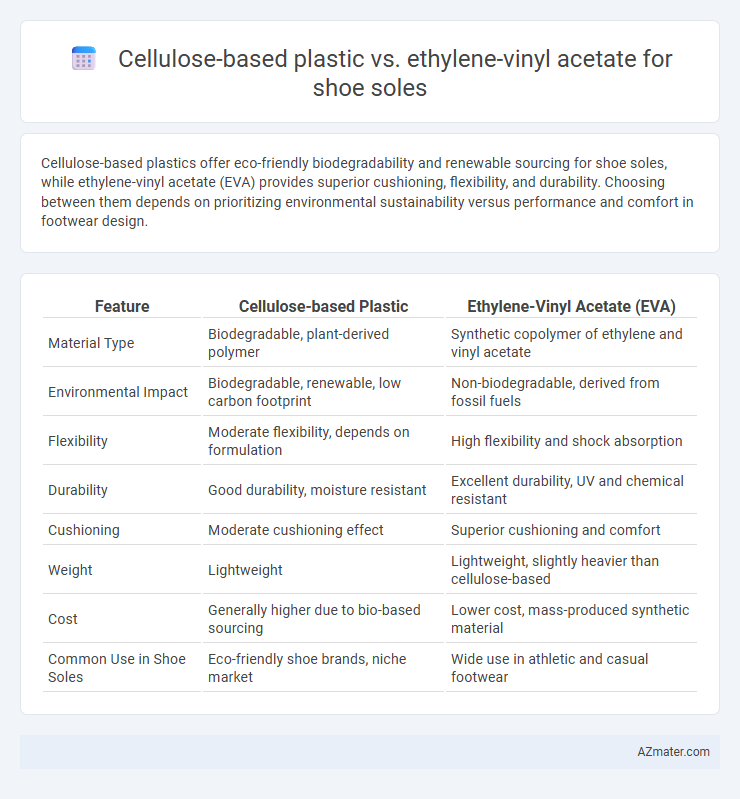Cellulose-based plastics offer eco-friendly biodegradability and renewable sourcing for shoe soles, while ethylene-vinyl acetate (EVA) provides superior cushioning, flexibility, and durability. Choosing between them depends on prioritizing environmental sustainability versus performance and comfort in footwear design.
Table of Comparison
| Feature | Cellulose-based Plastic | Ethylene-Vinyl Acetate (EVA) |
|---|---|---|
| Material Type | Biodegradable, plant-derived polymer | Synthetic copolymer of ethylene and vinyl acetate |
| Environmental Impact | Biodegradable, renewable, low carbon footprint | Non-biodegradable, derived from fossil fuels |
| Flexibility | Moderate flexibility, depends on formulation | High flexibility and shock absorption |
| Durability | Good durability, moisture resistant | Excellent durability, UV and chemical resistant |
| Cushioning | Moderate cushioning effect | Superior cushioning and comfort |
| Weight | Lightweight | Lightweight, slightly heavier than cellulose-based |
| Cost | Generally higher due to bio-based sourcing | Lower cost, mass-produced synthetic material |
| Common Use in Shoe Soles | Eco-friendly shoe brands, niche market | Wide use in athletic and casual footwear |
Introduction to Sustainable Shoe Sole Materials
Cellulose-based plastics derived from natural fibers offer biodegradability and reduced environmental impact compared to traditional polymers in shoe sole manufacturing. Ethylene-vinyl acetate (EVA) remains popular for its lightweight cushioning and flexibility, but faces challenges in recyclability and long-term sustainability. Innovations in cellulose composites emphasize renewable sourcing and decomposition, aligning with growing industry demands for eco-friendly footwear materials.
Overview of Cellulose-Based Plastics
Cellulose-based plastics, derived from renewable plant fibers such as wood pulp or cotton, provide a biodegradable and sustainable alternative for shoe sole materials. These bioplastics offer high tensile strength, good flexibility, and excellent breathability, making them suitable for comfortable and eco-friendly soles. Compared to ethylene-vinyl acetate (EVA), cellulose-based plastics reduce environmental impact through lower carbon emissions and enhanced biodegradability while maintaining competitive durability and cushioning properties.
Ethylene-Vinyl Acetate (EVA): Properties and Applications
Ethylene-vinyl acetate (EVA) is a lightweight, flexible polymer known for its excellent cushioning, shock absorption, and resistance to UV radiation, making it ideal for shoe sole manufacturing. Its low density and high elasticity provide superior comfort and durability in athletic and casual footwear. EVA's ability to maintain performance under varying temperatures and its resistance to stress cracking distinguish it from cellulose-based plastics in footwear applications.
Environmental Impact: Biodegradability and Sustainability
Cellulose-based plastics offer superior biodegradability compared to ethylene-vinyl acetate (EVA), breaking down naturally in soil and marine environments within months, reducing long-term pollution. EVA, a petroleum-derived polymer, persists longer in ecosystems due to its limited biodegradability, contributing to plastic accumulation and environmental strain. Sustainable sourcing of cellulose from renewable plant materials enhances its eco-friendly profile, while EVA relies on fossil fuels, raising concerns over carbon emissions and resource depletion in shoe sole production.
Durability and Performance in Footwear
Cellulose-based plastic offers eco-friendly durability with moderate abrasion resistance, making it suitable for lightweight and flexible footwear soles. Ethylene-vinyl acetate (EVA) exhibits superior shock absorption, elasticity, and long-term wear performance, enhancing comfort and resilience in high-impact activities. EVA's balance of cushioning and durability outperforms cellulose-based plastics in maintaining sole integrity under repetitive stress and varied environmental conditions.
Comfort and Cushioning Comparison
Cellulose-based plastic shoe soles offer natural breathability and moderate cushioning due to their biodegradable polymer structure, enhancing overall foot comfort by reducing moisture and heat buildup. Ethylene-vinyl acetate (EVA) soles provide superior cushioning and shock absorption through their flexible and lightweight foam composition, significantly improving comfort during prolonged wear and high-impact activities. While cellulose-based soles emphasize eco-friendly breathability, EVA excels in responsive cushioning, making it the preferred choice for performance-oriented footwear.
Production Processes and Scalability
Cellulose-based plastics for shoe soles are derived from renewable biomass through chemical modification and extrusion, emphasizing eco-friendly raw materials but facing challenges in large-scale uniformity and cost-effective production. Ethylene-vinyl acetate (EVA), synthesized via copolymerization of ethylene and vinyl acetate, benefits from well-established industrial processes enabling high scalability and consistent material properties. EVA's manufacturing advantages support mass production, while cellulose-based plastics require advancements in processing technologies to match commercial scalability in the footwear industry.
Cost Analysis: Cellulose-Based vs. EVA
Cellulose-based plastics generally present higher raw material costs compared to ethylene-vinyl acetate (EVA), primarily due to the complexity of sourcing and processing natural fibers. EVA remains more cost-effective for shoe sole manufacturing because of its established production scale, lower material expenses, and versatile properties like cushioning and flexibility. However, cellulose-based alternatives may offer long-term economic benefits through sustainability incentives and potential reductions in environmental compliance costs.
Consumer Acceptance and Market Trends
Cellulose-based plastics for shoe soles attract eco-conscious consumers seeking biodegradability and reduced carbon footprint, driving increased demand in sustainable footwear markets. Ethylene-vinyl acetate (EVA) remains favored for its lightweight, cushioning properties, and cost-effectiveness, maintaining strong market presence despite environmental concerns. Growing consumer preference for green materials accelerates innovation and adoption of cellulose alternatives, reshaping industry trends toward sustainability and biodegradable polymer adoption.
Future Prospects in Shoe Sole Innovation
Cellulose-based plastics offer sustainable advantages with biodegradability and renewable sourcing, making them a promising alternative for eco-friendly shoe soles. Ethylene-vinyl acetate (EVA) maintains high popularity due to its excellent cushioning, flexibility, and durability, but faces environmental concerns driving research into greener materials. Future innovations in shoe sole technology will likely focus on enhancing the performance of cellulose-based composites and developing hybrid formulations combining the eco-benefits of cellulose with the mechanical properties of EVA.

Infographic: Cellulose-based plastic vs Ethylene-vinyl acetate for Shoe sole
 azmater.com
azmater.com